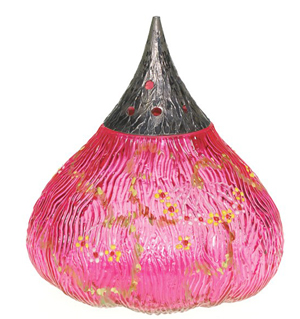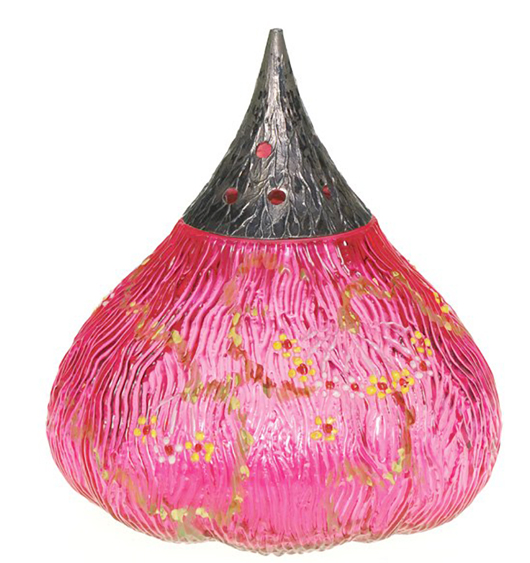
The first fig trees were brought to America from Spain in 1520. A ripe fig is very sweet, so it was often used when sugar was not available.
The Mount Washington Glass Co. of New Bedford, Mass., made fig-shaped containers for sugar and salt. The bottom was glass, the top silver-plated. The company also used the “figmold” shape for saltshakers with metal tops and for toothpick holders and glue pots that were altered to have open tops. The fig-shaped holders were made of translucent glass, satin glass, frosted glass and shaded glass in all colors. Many of the figs also were decorated with hand-painted flowers or other designs. Some collectors call this shape beet, onion or garlic. The Mount Washington fig pieces are popular, and some sell for thousands of dollars.
Q: At an estate sale in the 1950s, I bought a cherry drop-front desk with Queen Anne legs. It’s 39 inches high by 30 inches wide. There is a mark in a drawer that says: “Wilhelm Furniture Co., Sturgis, Michigan. Manufacturers of library and sewing tables, ladies’ desks, bookcases.” What is the desk’s value?
A: Stebbins Furniture Co. was founded in Sturgis in 1887. It was renamed Stebbins-Wilhelm Furniture Co. in 1907 and became Wilhelm Furniture Co. sometime between 1913 and 1917. Wilhelm Co. made desks, radio cabinets, bookcases, tables and smoking stands in a variety of woods and styles. The company closed in 1939. A cherry Wilhelm Co. desk recently sold for $70.
Q: My grandfather left us a three-handled porcelain tankard decorated with a blue and white medieval scene of a man and woman sitting at a table. The stamped mark on the bottom is a leafy wreath encircling a fancy monogram that appears to be “CAC.” Under the wreath is the word “Lenox.” How old is my tankard? Could it have been made by the same Lenox company that’s still around?
A: Your three-handled tankard is called a “tyg.” Tygs were filled with liquor and passed around the table after a big meal. “CAC” stands for Ceramic Art Co., a firm founded in Trenton, N.J., in 1889 by Walter Scott Lenox (1859-1920) and Jonathan Coxon (1843-1911). Coxon sold his share of the company to Lenox in 1896, but the company’s name didn’t change to Lenox Inc. until 1906. It is the same Lenox that is still in business, although its ownership has changed. The mark on your tyg was used from about 1896 to 1906, the decade when Ceramic Art Co. was solely owned by Walter Scott Lenox. So it’s an antique. If it’s in excellent condition, it would sell for more than $100.
Q: I inherited a picture of a horse named Greyhound, a world champion trotter. It says it is “an exact reproduction of the original by R.H. Palenske reproduced in talio-crome.” My father-in-law bought it at the Par Soap Co. in Oakland, Calif., in the 1930s. Can you tell us what talio-crome is?
A: Talio-crome is a printing process that uses red, green and blue to make all colors. “Talio” is derived from the word “intaglio,” the process of etching a design on a plate. Reinhold H. Palenske (1884-1954) was an artist born in Chicago. Greyhound was a famous horse, a trotter who set his first world record in 1935 when he ran from last place to first to win the Hambletonian in Goshen, N.Y. By the time he retired in 1941, Greyhound held 15 world records. The Harness Racing Hall of Fame called him the “Trotter of the Century.”
Q: I own an interesting tattered, trimmed and mended scarf about 23 inches square. The design on it is printed in red and white and includes portraits of French government officials. The title in a banner at the top reads, “Fourth Year of the French Republic 1795, Dresses of the Representatives of the People.” Another banner at the bottom reads, “Members of the Two Councils and of the Executive Directory: also of the Ministers, Judges, Messengers, Ushers and Other Public Officers.” My uncle is supposed to have brought this back from France after World War I. But why is it in English? And was it made for tourists?
A: Your antique textile probably dates from much earlier than World War I. It is copied from a print published in a 1796 book with the same title as your textile. The book was published in France first, but it was soon translated into English and published in London. It shows the proper dress of government officials in the French Republic. This was the era of the French Revolution, and people in England were curious about what was going on in France. It is likely the English were amused by some of the clothes shown in the print, too, because many of the officials were expected to wear uniforms that look like Roman togas. If your textile were in tip-top shape, it could be very valuable. As it is, it might be best to donate it to a historical society.
Q: I have one antique andiron from a set that belonged to my great-aunt, who was the niece of John Deere, the founder of the tractor company. Would one andiron be worth half as much as a pair?
A: Unfortunately, a single andiron would sell for considerably less than half the price of a pair. Even if a collector did not want to use the andiron, one does not display as well as two. And John Deere’s fame, in this case, is of no help.
Tip: Put a pad under any small rug to keep it from slipping. The pad also protects it from wear.
Sign up for our weekly email, “Kovels Komments.” It includes the latest news, tips and questions and is free, if you register on our website. Kovels.com has lists of publications, clubs, appraisers, auction houses, people who sell parts or repair antiques and more. Kovels.com adds to the information in this column and helps you find useful sources needed by collectors.
Terry Kovel answers as many questions as possible through the column. By sending a letter with a question, you give full permission for use in the column or any other Kovel forum. Names, addresses or email addresses will not be published. We cannot guarantee the return of any photograph, but if a stamped envelope is included, we will try. The volume of mail makes personal answers or appraisals impossible. Write to Kovels, Auction Central News, King Features Syndicate, 300 W. 57th St., New York, NY 10019.
CURRENT PRICES
Current prices are recorded from antiques shows, flea markets, sales and auctions throughout the United States. Prices vary in different locations because of local economic conditions.
- Skirt hem marker, wood and iron, used to measure and mark hemlines, marked “Boco patent pending,” 1930s, $30.
- Federal Glass patio snack set, Atomic Flower pattern, white with pastel pink, yellow, turquoise and black flowers, 1950s, eight pieces, $50.
- Dolly Darling doll, John & His Pets, brown hair, painted features, blue-and-white outfit, two dogs, two cats, duck, fencing, carrying case, Hassenfeld Bros., 1960s, doll, 4 inches, $65.
- Kitty in the Shoes toy, tin lithograph, windup, shoe moves forward then reverses, Yanoman Japan, original box, 1960s, 5 3/4 x 5 1/2 inches, $90.
- New Martinsville Glass Co. two-light candlesticks, Crystal Eagle pattern, Colonial Blue, wing design, inverted teardrop center, c. 1936, 5 3/4 in., pair, $125.
- Notre Dame Fighting Irish football patch, felt, football player on green clover, brown ground, 1930s, 6 1/2 x 8 inches, $130.
- Victorian Scottish sampler, green and red linen, wool and silk threads, alphabet, numbers, verse from “The Art of Charming” by Elizabeth Rowe, 1844, 16 inch square, $280.
- Holiday Inn mileage meter, black plastic, yellow and blue lettering, image of Holiday Inn sign, lists miles and routes to various cities, made by Willard C. George, 1950s, 7 x 10 inches, $750.
- Kickapoo Joy Juice store sign, tin, Lil’ Abner holding sign that says “Kickapoo Joy Juice Done Been Hoominized,” 62 x 31 inches, $995.
- Store counter, poplar, pine stain, raised panels, turned columns with beaded ball design, stepped baseboard, 1880-1900, 36 x 90 inches, $2,000.
Available now. The best book to own if you want to buy or sell or collect – and if you order now, you’ll receive a copy with the author’s autograph. The new Kovels’ Antiques & Collectibles Price Guide, 45th edition, is your most accurate source for current prices. This large-size paperback has more than 2,500 color photographs and 40,000 up-to-date prices for more than 775 categories of antiques and collectibles. You’ll also find hundreds of factory histories and marks, a report on the record prices of the year, plus helpful sidebars and tips about buying, selling, collecting and preserving your treasures. Available online at Kovelsonlinestore.com; by phone at 800-303-1996; at your bookstore; or send $27.95 plus $4.95 postage to Price Book, P.O. Box 22900, Beachwood, OH 44122.
© 2012 by Cowles Syndicate Inc.
ADDITIONAL IMAGE OF NOTE



